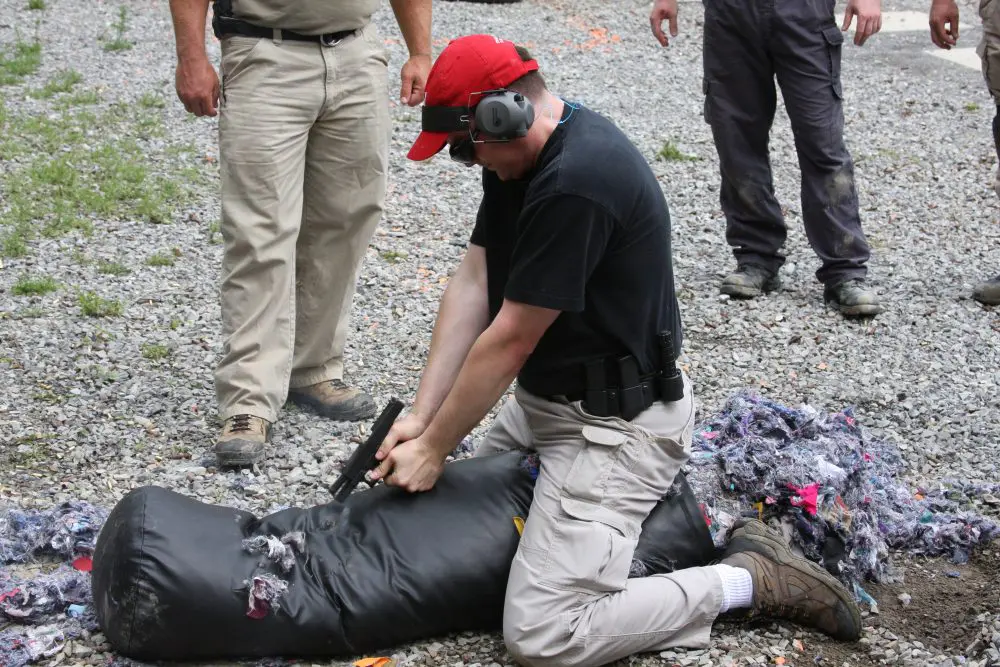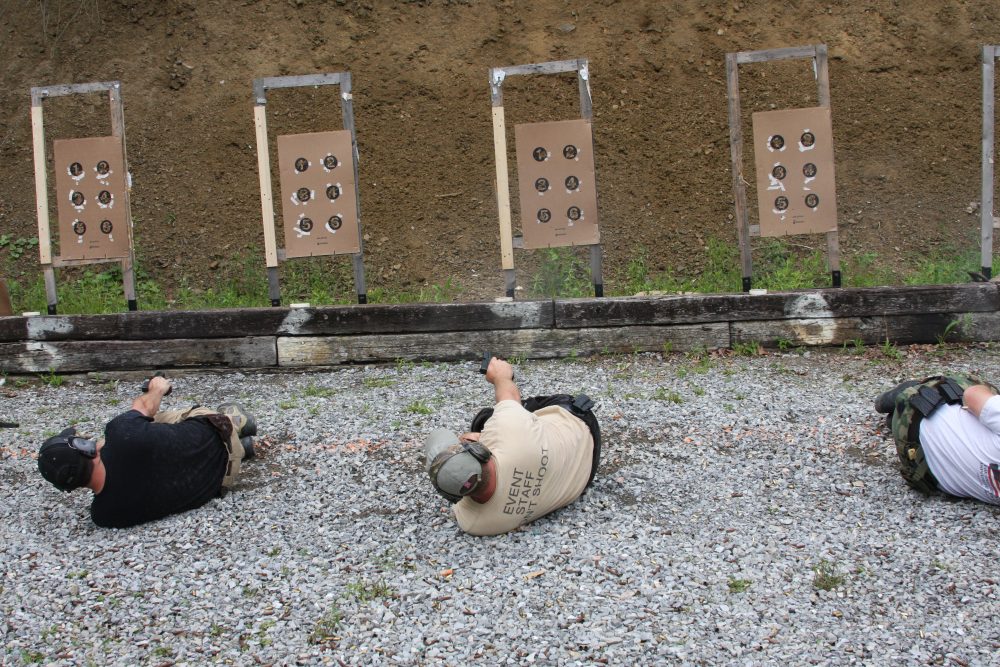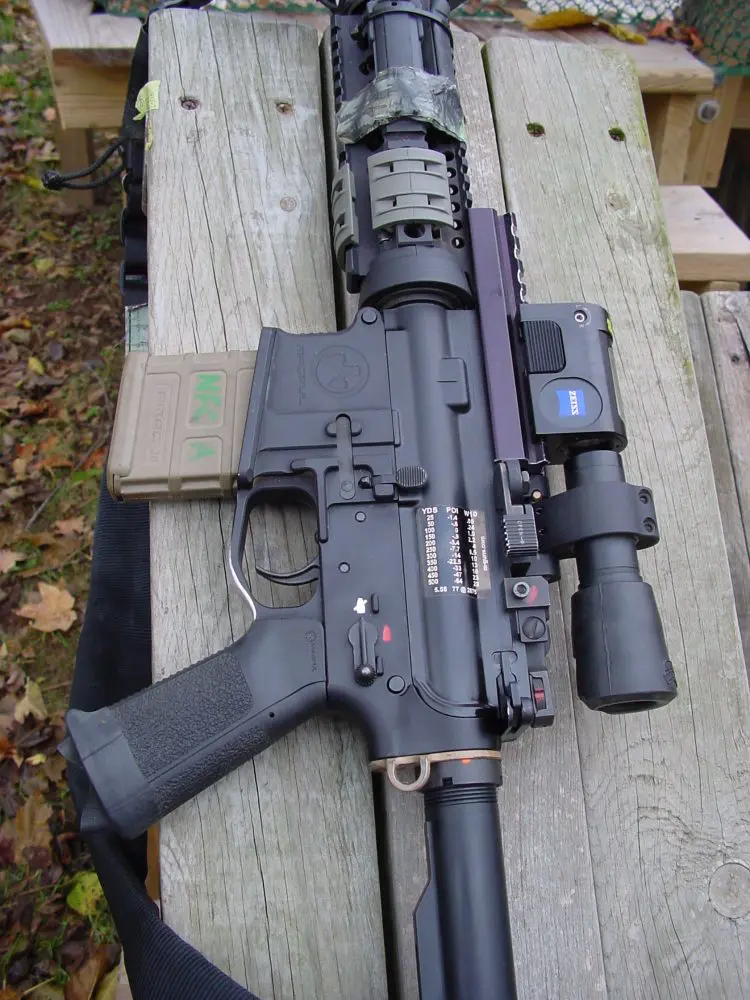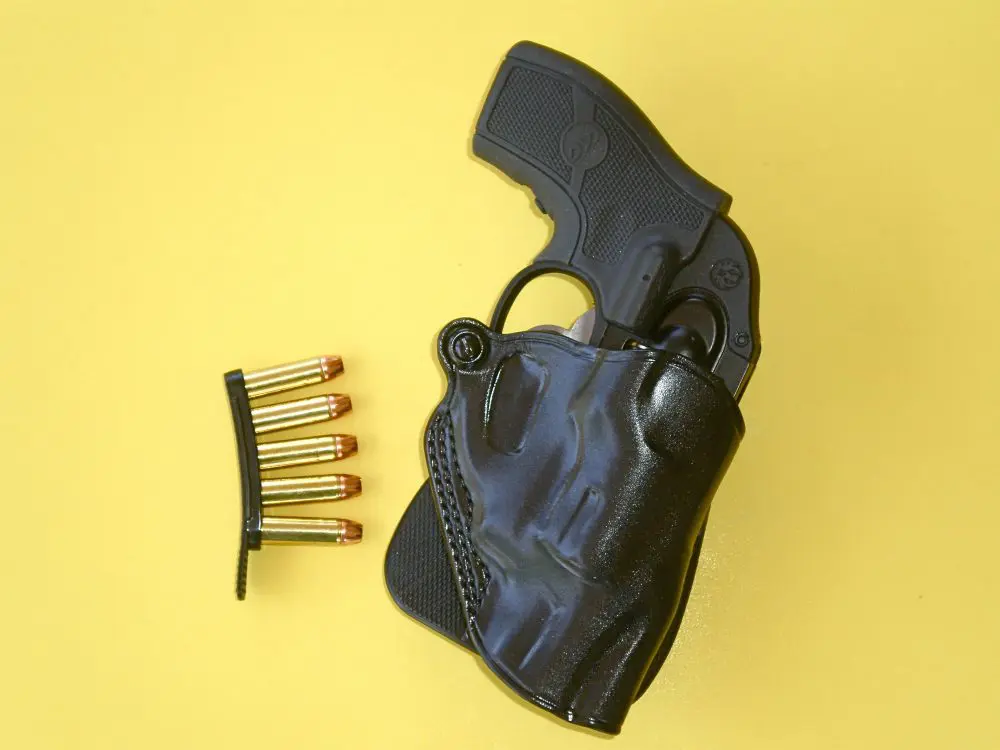One of many unique drills employed by Tactical Response is for students to engage 100-pound punching bag. Students are constantly challenged by what might be next.
“FIGHT!”
That single word sums up the four-day training experience at recent Tactical Response Fighting Pistol and Advanced Fighting Pistol courses held at Hollidaysburg, Pennsylvania.
James Yeager is the owner of Tactical Response and served as lead instructor during the courses, with instructor Jay Gibson also keeping the students on track during the four days of training. Yeager and Gibson’s full resumes are listed on Tactical Response’s well-executed website. Both men are imminently qualified to instruct and are dynamic teachers, each with their own style.
Professionalism and safety were stressed at all times, as students were constantly pushed to the mental and physical limits of their handgun proficiency. Yeager is very clear that the courses are about fighting with a pistol, not about sterile marksmanship.
The Tactical Response Fighting Pistol courses do address handgun accuracy, but only as a way to end the fight more effectively. Misses mean nothing, no matter how fast you miss.
The constant mantra of the entire four days is “Move Off the X.” Someone is much more likely to survive a hostile encounter if he does not freeze in place when attacked. The concept of moving while drawing a weapon, reloading, or performing malfunction drills was constantly hammered home. Students’ eyes were to be kept downrange at all times when conducting drills, reloading, picking up magazines, scanning area for new threats and re-holstering.
Student provides cover while teammate applies tourniquet and pressure bandage to simulated wound. This drill followed lecture on gunshot wounds and treatment procedures.
The instructors would concisely introduce a new drill or concept and then move rapidly to the line to implement.
Fighting Pistol had 12 students enrolled and Advanced Fighting Pistol had seven. Both Yeager and Gibson hovered behind students, pointing out transgressions and giving encouragement on how best to improve. Students were not berated or spoken to condescendingly, but mistakes were pointed out quickly, with succinct instruction on how to fix the problem.
All drills were conducted at close range, which makes sense considering this is where most defensive encounters take place. Accuracy was stressed over speed in all drills. One should not expect that merely keeping all rounds in the silhouette is acceptable. Yeager constantly emphasized that only heart and brain stem hits count. A review of handgun terminal ballistics was discussed to support his contention.
Students joked this was Tactical Response instructor’s favorite drill. Emphasis was to fight through no matter what conditions were experienced.
Students were constantly encouraged to watch their front sight. Point shooting works for hitting center mass, but even at three to five yards, the front sight must be consulted to produce precise shot placement. Different styles of targets and drills were used to emphasize how important it is for a student to watch the front sight while correctly pressing the trigger to the rear. Aimed fire was stressed, with XS Sight Systems’ Big Dot sight system advocated by Yeager.
I showed up with XS Sight’s Big Dot on my Glock 17 due to previous experience, and was not disappointed with the Big Dot’s performance. Precise headshots were taken out to ten yards. I found accuracy was increased with the Big Dot, especially during one-handed drills or while shooting on the move. My back-up pistol was a Glock 19 that was not equipped with XS Sight’s Big Dot. The difference was striking when I used the Glock 19 during one of the four days of shooting. I did this to better analyze the Big Dot’s performance. My Glock 19 was equipped with the Big Dot when I got home.
Tactical Response students in various stages of drill. Some engage target, others scan 360 degrees, a few change magazines and reholster—all one-handed.
A brief word on equipment used during the courses.
My pistol of choice for personal defense is a Glock. I used a Glock 17 and Glock 19 during these four days. Glock pistols dominated both courses, with a few Smith & Wesson M&Ps and one 1911-style pistol. The most popular caliber was 9mm—over half of the participants used it—with .40 S&W and .45 ACP filling in the rest. I used a combination of Black Hills, Winchester and Wolf ammunition for my 2,000-round ammunition allotment.
Yeager encourages students to attend with the carry gear they would normally utilize for day-to-day carry. In other words, no speed rigs if you are a civilian practitioner of concealed carry. Only two law enforcement officers were in attendance, with the rest of the class made up of private citizens. I used BlackHawk CQC magazine carriers, BlackHawk 1.5” CQC belt, BlackHawk Warrior Wear Tactical pants and boots. My holster was a Comp-Tac Victory Gear FBI paddle holster. I had no gear malfunctions or issues of any kind during the four days.
Too many techniques and drills were covered to be fully explained in this article. I will give a synopsis with the caveat that readers should make plans to attend one of Tactical Response’s Fighting Handgun courses—or any other course, for that matter.
Any reputable trainer will stress keeping up to date with training. Along this line of reasoning, there are items in the Tactical Response training that must be personally experienced to fully grasp.
Even when engaging targets from unorthodox positions, Tactical Response instructors stressed front sight and trigger control for accurate shot placement. Thinking was, you’re in a bad situation and solid hits are a must.
The first day of training started out with a safety brief and description of material to be covered. The mindset of “never stop fighting or moving” was stressed above everything else. Handgun proficiency is important, and shooters must be familiar with the operation and malfunction drills of their particular weapon of choice. However, this is ancillary to establishing an effective fighting mindset.
If the unfortunate day arrives when you must defend yourself or loved ones, it is going to be mindset, training and willingness to fight without mercy that will see you through successfully—not a particular handgun or caliber. Tactical Response is very clear on this and refuses to get drawn into the minutiae of caliber choices and other mundane topics that often dominate discussions of personal defense.
After the safety briefing and introduction of what was expected in terms of moving when drawing and reloading, malfunction drills, and fighting mindset, students found themselves on the line all day. Before live fire commenced, the correct drawstroke was drilled.
Tactical Response Instructor Jay Gibson ran students through a four-step draw sequence. It was pointed out that the grip you have on the pistol from the holster will be the one you will be forced to fight with for the duration. More than likely, you will not have time to reconfigure your grip if you mess it up coming out of the holster. The saying “smooth is fast” comes to mind.
Students move off the X at “FIGHT!” command and engage targets. Premium was placed on movement and accurate shot placement.
Live fire drills began with the basics of placing rounds accurately on target by concentrating on trigger control and sight alignment. These two concepts were the foundation of all accurate shooting during the various drills. One drill consisted of slowing increasing pressure on your pistol’s trigger on Yeager’s command until the shot unexpectedly broke.
At no time did the Tactical Response instructors tell us to shoot faster. The emphasis was on well-aimed shot placement in every drill. Live-fire drills ran the gamut, including one- and two-handed shooting, shooting on the move (both laterally and forward/backward), covert carry, use of cover/concealment, reloading, retention drills, malfunction clearance drills and various shooting positions ranging from supine to fetal, sitting and kneeling.
The second day of Fighting Pistol began with one of the better lectures I have heard concerning the legal aspects of deadly force, handgun stopping power, mental conditioning for deadly force encounters and OODA (Observe, Orient, Decide and Act) Loop decision-making process.
Yeager urged everyone to have a plan and stay in a heightened alert condition. He advocated avoiding conflicts and not placing oneself in precarious positions as the more prudent option versus having to resort to deadly force. As Yeager pointed out, deadly force will prove costly in terms of criminal defense, civil defense and the mental condition of a person forced into using deadly force. In closing, however, he did stress that if you find yourself with no alternative but to fight, finish it in the quickest, most efficient manner.
The last part of the Fighting Pistol course consisted of more live fire drills combining skills learned over the two-day course.
Advanced Fighting Pistol course had students shoot one-handed just as often as two-handed in effort to hone skills and force concentration on front sight and trigger press. Students will find one-hand use likely when reacting to attacks, and Tactical Response wants to prepare students for this.
The Advanced Fighting Pistol’s curriculum made up the last two days of my training experience with Tactical Response. Yeager is insistent that the Advanced Fighting Pistol course not be taken until Fighting Pistol has been successfully completed. I can appreciate this much better now that I have taken both. A student would be behind the curve in the Advanced Fighting Pistol class both in terms of skill sets and mental preparedness without first taking Fighting Pistol.
Tactical Response introduced several techniques/methods that I found intriguing during training.
A student is taught to always conduct a full 360-degree scan after completing every drill. This helps to limit the effects of tunnel vision and auditory exclusion that often accompany high-stress, adrenaline-pumping encounters. Another signature feature is that a speed load follows every 360-degree scan, with the slide racked chambering a fresh round.
When queried about this, Yeager feels that racking the slide is necessary, as every malfunction drill involves first tapping the base of the magazine and then racking the slide. A single across the board method is needed when hands turn into “flippers” and fine motor skills are lacking when under life-and-death stress conditions.
The slide rack is taught a specific way, with the pistol held in a retention position close to the chest and the off hand reaching over the slide and racking the slide as if “you are trying to pull it off the gun’s frame.”
Plastic dummy rounds are distributed to the students at the beginning of the course, with the students told to incorporate at least one into every reloaded magazine. This ensures “tap, rack, and bang” malfunction drills are worked on throughout the course. Take my word for it—this works. I have never done malfunction drills as smoothly or naturally until exposed to this teaching technique.
Finally, Yeager incorporates a 100-pound punching bag in a ground fighting scenario that transitions into engaging targets with your handgun.
A student starts by straddling the bag and being told to “FIGHT!” The student engages the bag for 30 seconds with a series of elbow and open palm strikes, all with fellow students urging him on. I cannot describe how much this simple action gets the blood pumping and the heart rate up. The 30 seconds seem to last for minutes.
Upon command, the student then disengages from the bag and engages targets as indicated by the instructor. Both James and Jay are close at hand to ensure safety. I could write a 30-page article describing all the different drills and insights offered by the Tactical Response instructors that I don’t have space to talk about here. One solution is for readers to experience these courses firsthand.
Tactical Response does a good job of incorporating all of the different drills and techniques into a comprehensive skill set. Each student progressed rapidly in skills and confidence during each course. I suggest Fighting Pistol and Advanced Fighting Pistol be taken back-to-back in order to maximize the training opportunity, but I understand this may not be possible for all students due to time constraints.
I was very impressed with Tactical Response. I cannot urge readers enough, whether experienced operators or novices seeking their first formal firearm instruction, to train with Tactical Response. This is one fight club you can, and should, talk about.
SOURCES:
Tactical Response
Dept. S.W.A.T.
P.O. Box 385
Camden, TN 38320
(877) 7-LETHAL
www.tacticalresponse.com
BLACKHAWK!
Dept. S.W.A.T.
6160 Commander Pkwy
Norfolk, VA 23502
(757) 436-3101
www.blackhawk.com
Black Hills Ammunition
Dept. S.W.A.T.
P.O. Box 3090
Rapid City, SD 57709
(605) 348-5150
www.black-hills.com
Comp Tac Victory Gear
Dept. S.W.A.T.
P.O. Box 1809
Spring, TX 77383
(281) 209-3040
www.comp-tac.com
Glock
Dept. S.W.A.T.
6000 Highlands Pkwy
Smyrna, GA 30082
(770) 432-1202
www.glock.com
Winchester Ammunition
Dept. S.W.A.T.
427 N. Shamrock St.
East Alton, IL 62024
(615) 258-3340
www.winchester.com
Wolf Ammunition
Dept. S.W.A.T.
P.O. Box 757
Placentia, CA 92871
(888) 757-9653
www.wolfammo.com
XS Sight Systems
Dept. S.W.A.T.
2401 Ludelle
Ft. Worth, TX 76105
(888) 744-4880
www.xssights.com













